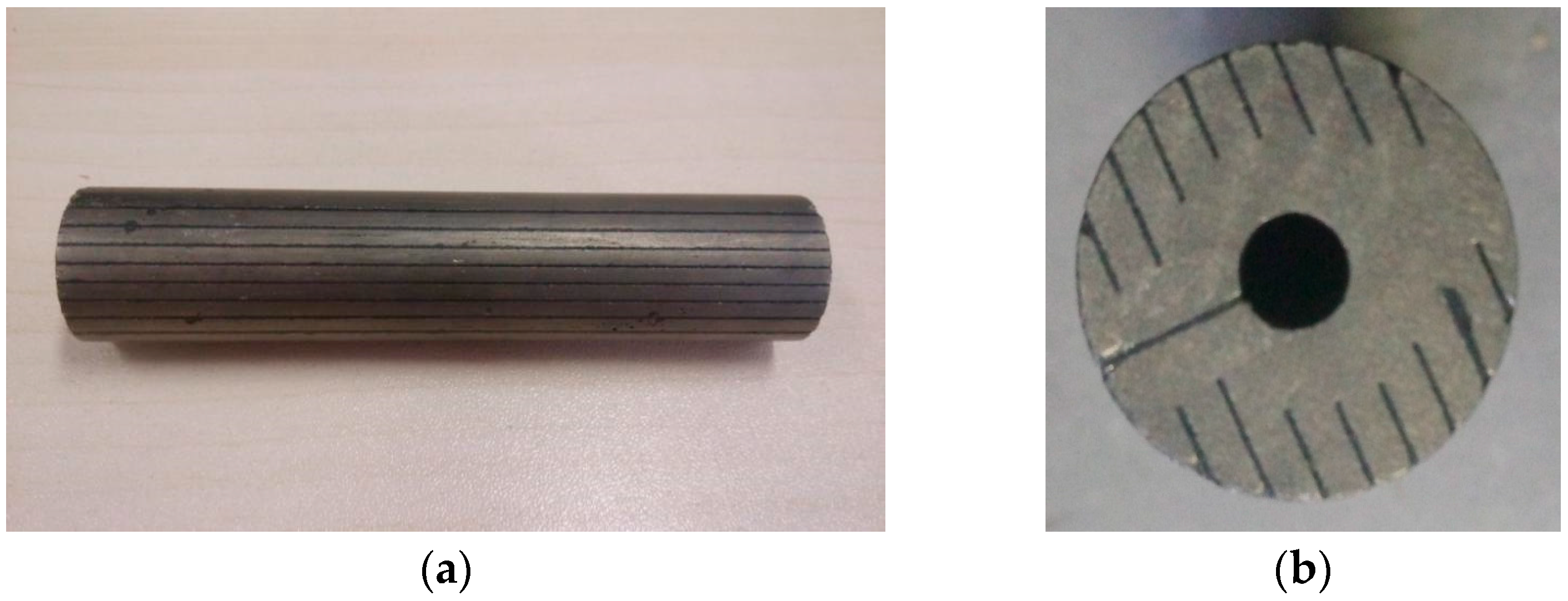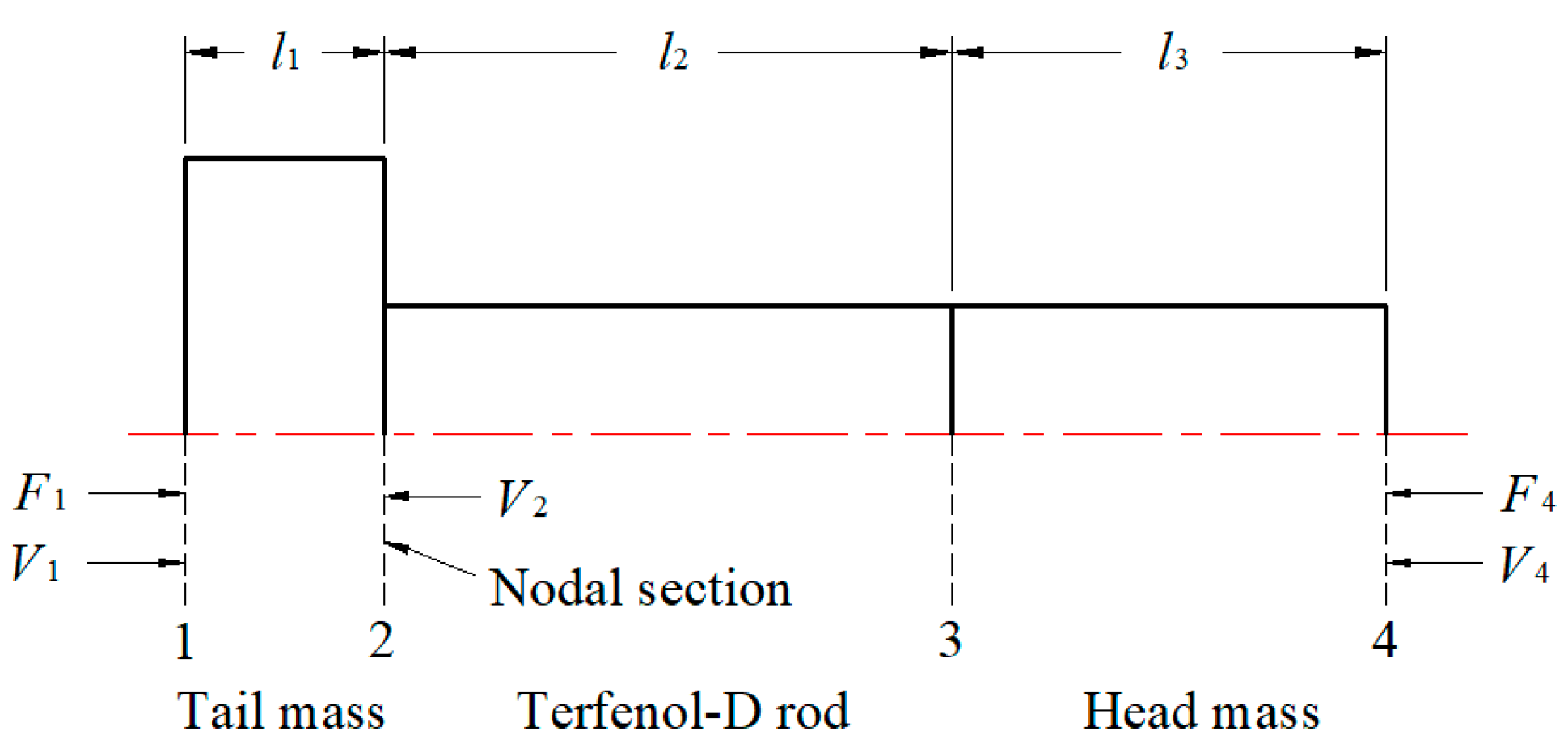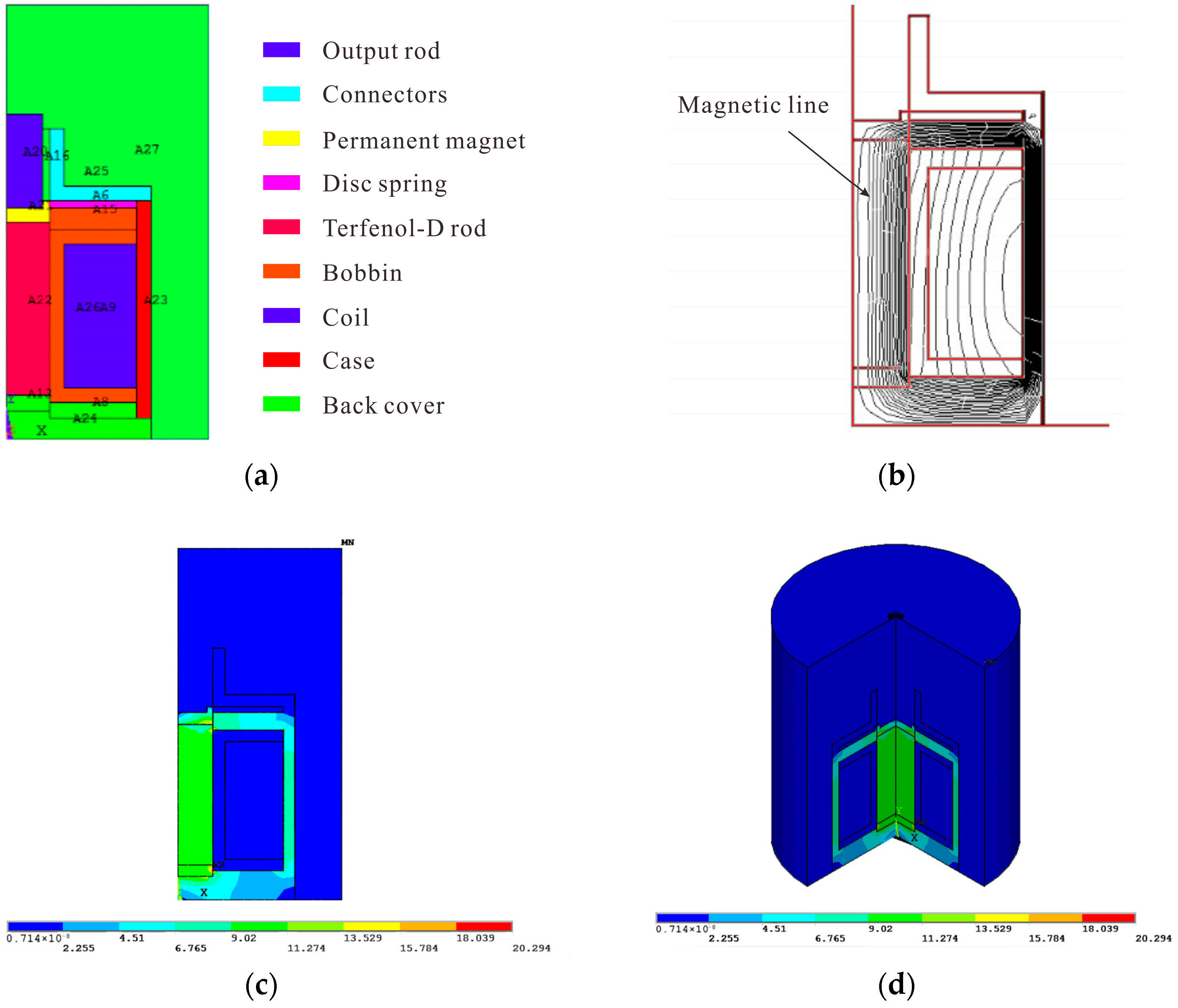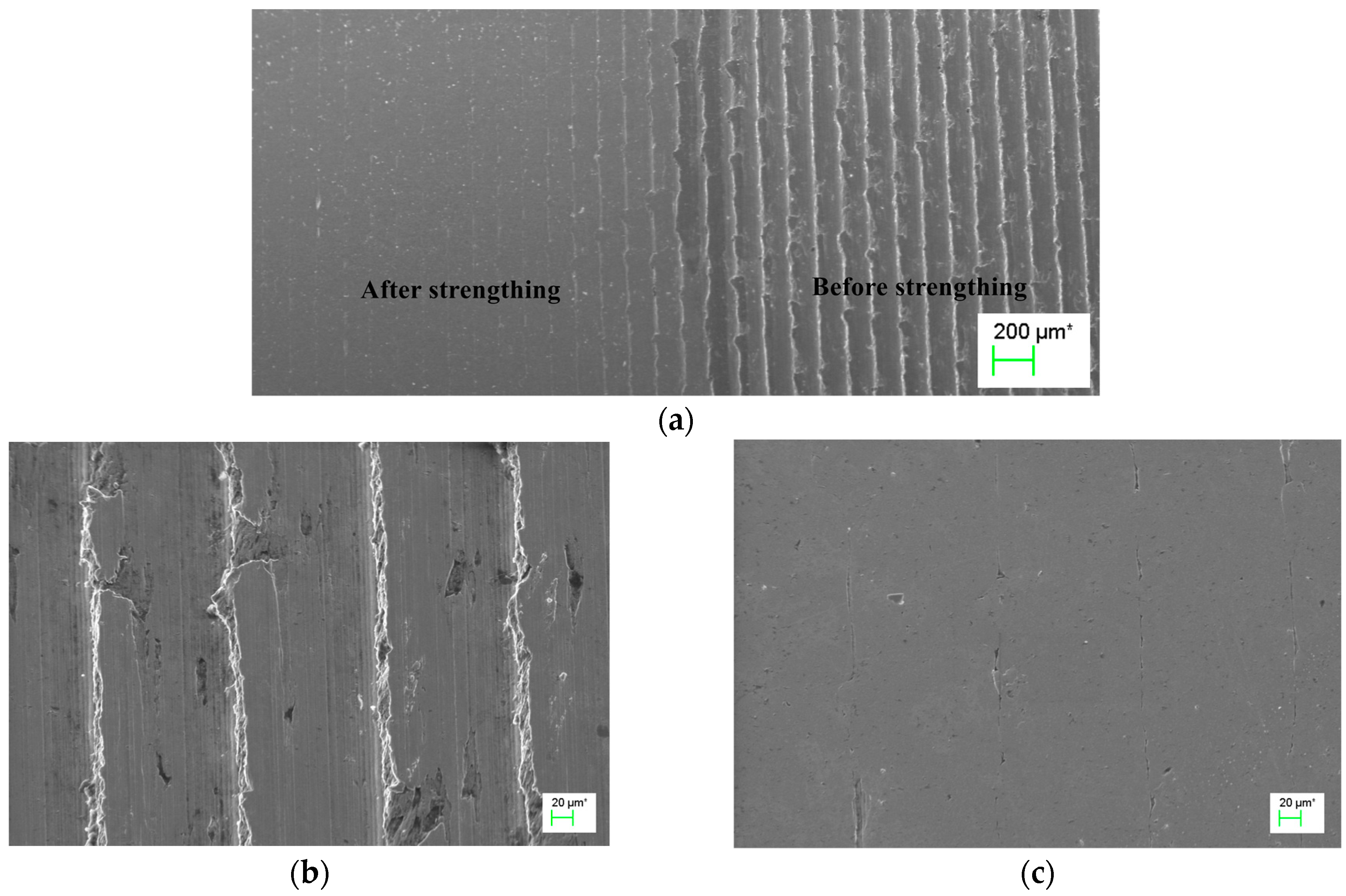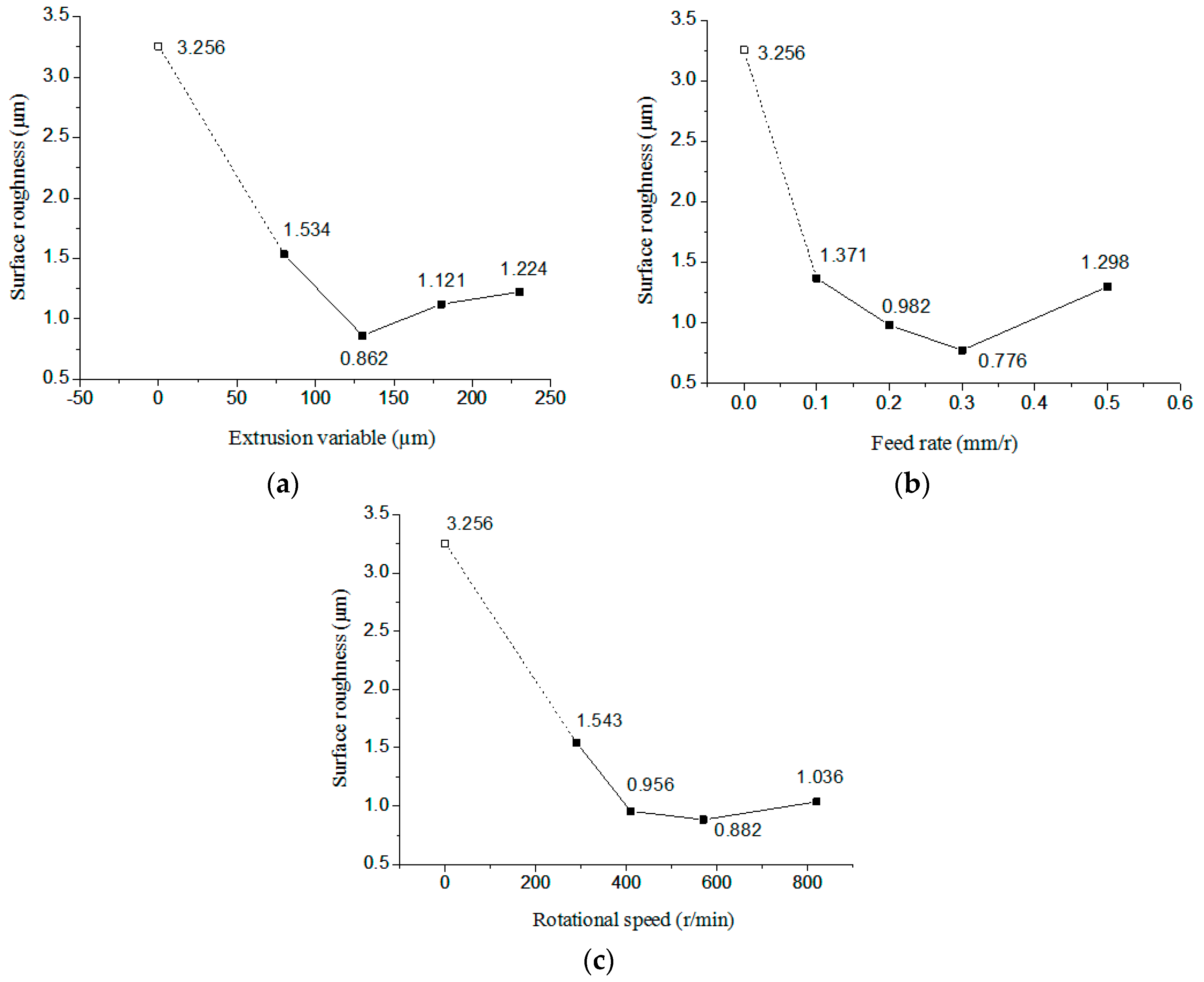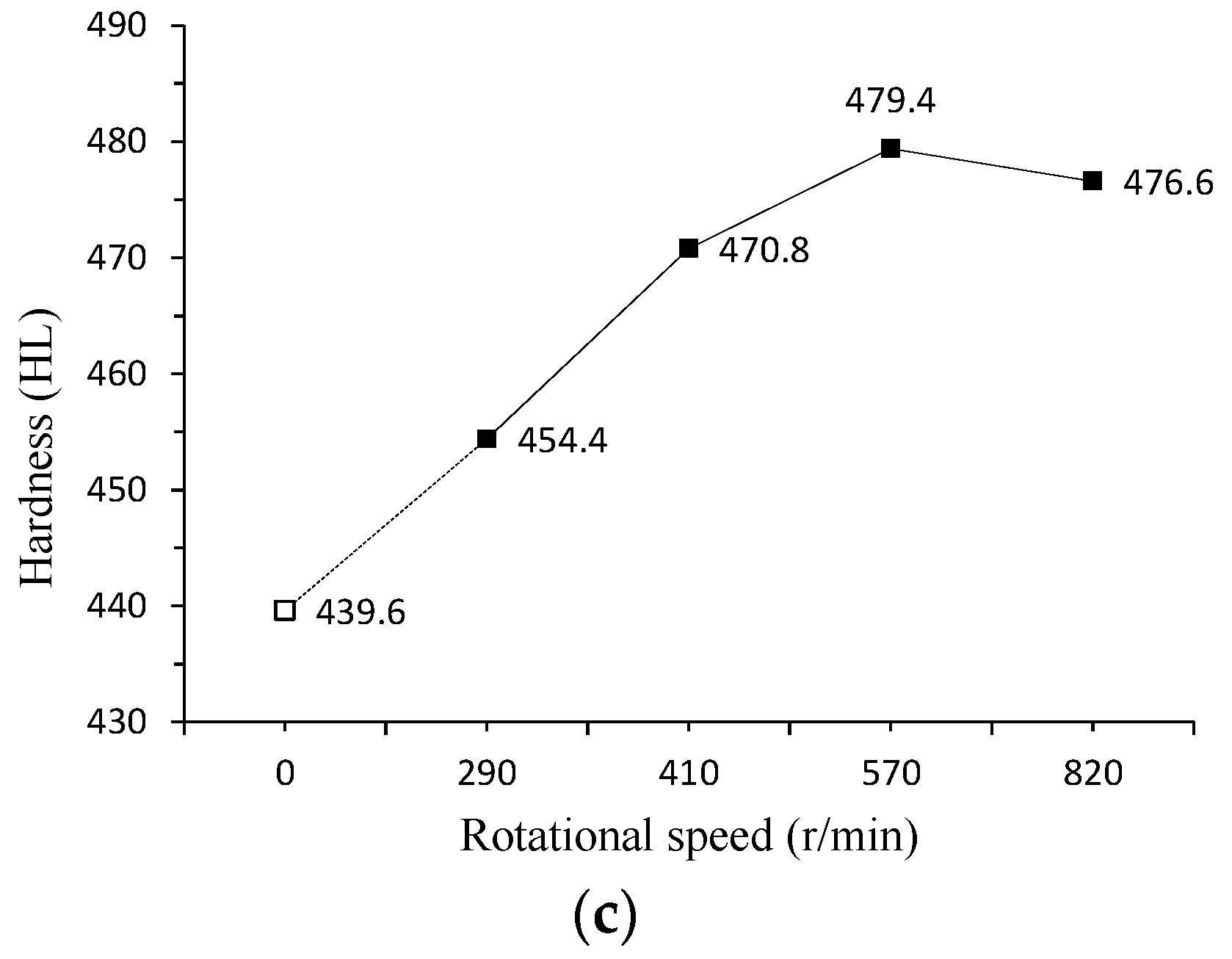1. Introduction
Because the surface quality of parts will directly affect the fatigue life, in order to improve the surface quality and precision, parts often need further processing after finishing. More and more methods have been applied to the surface strengthening processing of the parts in modern times. Among that the most common methods include shot peening, rolling strengthening, and ultrasonic vibration extrusion strengthening, etc. Shot peening is mainly used to improve the fatigue properties of metallic components by introducing compressive residual stress and producing strain-hardening in surface layer. Xiao et al. [
1] find that impacting density has obvious influence on the peening effects of random and regular peening patterns. It is often used in the parts that are under high stress condition. Also, the thickness of the workpiece can not be too thin (above 2 mm). Rolling strengthening is a kind of plastic processing method. The smooth roller with high hardness have a direct contact with the surface of the workpiece, making the surface produce micro plastic deformation, and then the surface roughness will be improved. After rolling strengthening, work-hardening, and residual stress caused by the plastic deformation on the surface of the workpiece will improve its fatigue strength. Altenberger et al. [
2] analyze the effect of deep-rolling on the stress-controlled low and hige cycle behavior of Ti
6Al
4V. The surface of the alloy steel surface is reinforced after rolling strengthening. The hardness of the hardened layer is about 0.1–0.8 mm. The improvement of the parts’ surface quality is significantly limited for the reason that the strengthening layer is shallow.
In recent years, ultrasonic machining has developed rapidly and been used in various fields, including ultrasonic liquid abrasive machining, ultrasonic cleaning, ultrasonic welding, ultrasonic-assisted machining, and ultrasonic lithotripsy which is applied to the medical field. Moreover, ultrasonic surface strengthening technology has been proposed and applied in recent years. Fang et al. [
3] propose a processing method that the processing head with the compressive pre-stress and high frequency longitudinal impact force hits the workpiece surface to flatten the micro peak-valley on it. At the same time, Surface plastic deformation occurs and the compressive stress is formed, which can improve the surface quality of the workpiece.
At present, the transducer used in ultrasonic machining is mainly piezoelectric ceramic transducer, but its amplitude is small and it needs an ultrasonic horn to amplify the amplitude, which causes power loss. Clark [
4] finds that magnetostrictive coefficient of the binary rare-earth iron compounds is significantly large at room temperature, and the Curie temperature is etremely high. Therefore, it is called the rare-earth giant magnetostrictive material. Among them, the properties of Tb
1-xDy
xFe
2 (0.68 ≤
x ≤ 0.73) is optimal, and the commodity number is Terfenol-D. According to the research results of Grunwald [
5], Terfenol-D offer very attractive and valuable features. The precise small motions with high energy density and fast control response could be applied as well in some automotive and aerospace applications.
Then, with the continuous improvement of this kind of material in the preparation process, the research and application of rare-earth magnetostrictive transducer has entered a stage of rapid development. Zhu et al. [
6] report that the rare-earth giant magnetostrictive transducer was first used in low frequency sonar systems by the United States Navy Department, and its resonant frequency of the coil could reach 2000 Hz. In Japan, Wakiwaka et al. [
7] designed a sonar transducer with 8 Terfenol-D rods. The electromechanical coupling coefficient of the transducer is 73%, and the signal of acoustic source reaches 192 dB. Dhilsha et al. [
8] designed a low frequency giant magnetostrictive transducer. The rare-earth giant magnetostrictive transducer has the advantages of high power, large amplitude and no overheating failure. Son and Cho [
9] have constructed an under water sonar transducer using Terfenol-D rod employing open magnetic circuit in order to improve the heat dissipation problem of sonar transducer using Terfenol-D. The sound radiation power can reach to 200 dB at input power of 650 VA at the resonance frequency. In the United States, Stillesjo et al. [
10] introduce that Etrema has developed CU18A magnetostrictive transducer whose working frequency is 15~20 kHz, the output amplitude is 6~10 µm, and the interior is able to withstand 150 °C which can be applied in ultrasonic welding. Effect of prestress on the dynamic performace of a Terfenol-D transducer has been studied [
11]. The dynamic response of the transducer can be explained as the interaction between the frequency dependent AC losses and the mechanical resonance. For solving the eddy current, Wang et al. [
12] propose a giant magnetostrictive actuator based on the use of permanent magnet. Permanent magnet is used for driving magnetic field of Terfenol-D and this method avoids effect of temperature that is caused by skin effect and eddy current of solenoid. Karunanidhi et al. [
13] design a magnetostrictive actuator with flexure amplifier and a magnetically biased magnetostrictive actuator for application in high frequency flapper–nozzle servo valve. It has satisfactory static and dynamic characteristics for applications in high-speed actuation systems. Sheykholeslami et al. [
14] carride out an experimental comparative study between first and second longitudinal modes of vibration in the Terfenol-D transducer. Results show that higher quality factor in the second mode shape and it has lower sensitivity with Young modulus. Moreover, Δ
E effect and its influence on vibrational behavior of the this transducer have been studied [
15]. With this type of transducer, Δ
E effect leads to a change in the resonance frequency about 4 percent. The performance of the transducer can be affected negatively if this effect is neglected. They continue to propose an approach to design and fabrication of resonant giant magnetostrictive transducer [
16]. This approach can make the transducer having high mechanical quality factor and low damping coefficient. Potential applications of the magnetostrictive technology in simple, high energy density structures with fast responses extend over a range of different industries.
Researches show that ultrasonic surface strengthening technology requires large power, high vibration velocity and displacement amplitude under some process conditions. Good stability of the vibration system is important as well. In addition, the ultrasonic transducer is the key to meet these requirements. Some experiments show that the increase of the vibration speed within the allowable range of the system stiffness can improve the processing efficiency. For the piezoelectric transducer, when the vibration amplitude is too large, the amplitude of tool head will fluctuate periodically due to the precision and power limitation of piezoelectric transducer. This can result in slight light and dark stripe on the surface of the workpiece, and the quality of the workpiece surface will decrease. Features of magnetostrictive applications like power density, precision and dynamic performance are excellent catalysts for the implementation of the technology in high volume applications. Terfenol-D have been developed with stable characteristics over a wide range of temperatures and have a high magnetoelastic coefficient [
17]. It is hard for rare-earth ultrasonic transducer to lose polarization and become aging for the characters of magnetostrictive material. It is of great help to ultrasonic surface strengthening technology because of the stronger ability to apply electric power for the magnetostrictive material’s large power density and small size and light weight for its low Young’s modulus [
18]. So it is worthwhile to use rare-earth giant magnetostrictive materials instead of piezoelectric ceramics to make the transducer that is used in the field of ultrasonic surface strengthening technology.
Therefore, this paper introduces the design and finite element analysis of rare-earth giant magnetostrictive ultrasonic transducer. Additionally, the experimental study on the ultrasonic surface strengthening technology baised on the transducer was conducted.
3. Finite Element Analysis of Rare-Earth Giant Magnetostrictive Ultrasonic Transducer
The working performance of rare-earth ultrasonic transducer is closely related to the natural frequency of the compound vibrator: excitation part (based on magnetostrictive material: Terfenol-D rod), backing part (tail mass: balance weight), and matching part (head mass: output rod). Only the work frequency of the transducer near the natural frequency of the Terfenol-D, can the output amplitude reach the maximum value. Its working performance is related with the closure and the uniformity of the magnetic field. Therefore, in this paper, modal analysis is made to get the natural frequency of the compound vibrator. The magnetic field transducer structure is analyzed to examine the rationality of the structure and materials.
3.1. The Finite Element Analysis of the Composite Oscillator Vibration Modal
The vibration of Terfenol-D rods, output rod and counterweight are concentrated in the axial direction because of their cylindrical structure. So, only the axial vibration can be taken into account when analysing. The water cooling system will provide big cavity for water flowing, which will affect the work frequency of the transducer. The working state of the transducer may decrease significantly at high frequency (usually for more than 20 kHz). So, the performance of the transducer is tested in the frequency range: 10~30 kHz.
As illustrated in
Figure 4a, the slicing-designed The Terfenol-D rod with size of Ø20 × 100 mm was adopted in this paper, central empty with a diameter of 5 mm. There is a permanent magnet at each end of the Terfenol-D, so it is added to the analytical model of the compound vibrator. The boundary conditions was set as that both ends of the compound vibrator were free and the nodal section was fixed. The output rod is made of hard aluminium and the counterweight is made of stainless steel. The parameters of density, elastic modulus, and Poisson’s ratio are set according to
Table 1.
From the analysis of
Figure 4b, the following conclusion can be achieved: the working frequency of the transducer should be guaranteed at about 15,204 Hz, and the composite oscillator will have relatively better vibration mode, without bending and torsion. This provides a research basis for the study of the later transducer and ultrasonic surface strengthening test.
3.2. Finite Element Analysis of the Magnetic Field
The working performance of Terfenol-D depends on the closeness and uniformity of the magnetic field. The closeness and uniformity of the magnetic field depend on the material properties of each part of the transducer (the most important is the permeability of the material). The purpose of magnetic field analysis is to verify that the selection of the material is rational and there is no obviously magnetic leakage phenomenon in the whole structure. This provides the basis for the follow-up production of the transducer.
The impact of the inlet and outlet of water as well as the signal line access are ignored in order to simplified the model of transducer. So, the transducer can be approximated as an axial symmetry model. Two-dimensional geometric model of transducer is established, and the material parameters used in modeling are shown in
Table 2.
After modeling, different material properties are assigned and each region is numbered, as shown in
Figure 5a. Then, the analysis continues with meshing the model and setting the boundary conditions: applying a magnetic lines parallel conditions for model peripheral nodes. And the current density is 6 A/mm
2.
After calculation, it can be seen from
Figure 5b that the magnetic field is well sealed and the transducer does not show obvious magnetic flux leakage phenomenon. The distribution of magnetic line is uniform, which basically meets the magnetic lines closed principle. As can be seen from
Figure 5c,d, the magnetic flux density of the entire transducer distributed unevenly. But, the maximum magnetic flux density of the Terfenol-D rod in the middle and the loop circuit basically meets the working requirements of the transducer. So, for it can meet the design requirements of the transducer in general, the design of the magnetic circuit structure and material selection is rational.
3.3. Performance Testing of the Rare-Earth Giant Magnetostrictive Transducer
In the actual production process, due to a series of external factors, such as temperature, static and dynamic load, abrasion of transducer, and different workpieces, the natural frequencies of the ultrasonic vibration system will fluctuate in a small range. In order to solve this problem, the ultrasonic driver of the transducer must have the function of automatic frequency tracking. The TH-CC-1 type ultrasonic driver is used in this paper. It has different frequency gears and there is a frequency tracking range at one gear. So the ultrasonic driver can realize the real-time tracking of the optimal resonant frequency of the transducer near the gear. According to the above analysis, these three frequency gears (15 kHz, 20 kHz and 25 kHz) are used to measure the amplitude of a transducer. The vibration amplitude of the ultrasonic transducer under different waveform and frequency is measured and the results are shown in
Table 3.
Analysis of results: according to the above test results, it is not difficult to see that when the frequency is the same, the amplitude of the ultrasonic transducer under square wave is the largest, and under the same waveform, as the frequency increases, the amplitude of the transducer has a tendency to decrease. The amplitude reached the maximum at the frequency of 15 kHz under square wave, and this provides the basis for the follow-up ultrasonic surface strengthening test.
The performance of ultrasonic transducers are usually described using the quality factor, which can be obtained in accordance with impedance analysis of the transducer by impedance analyzer.
f1 and
f2 are the frequencies that the displacements of the transducer were attenuated by 3 dB. Δ
f = f2 −
f1 shows bandwidth of the transducer.
f1,
f2 and resonant frequency
fs are measured by impedance analyzer:
fs = 15,107.3 Hz;
f1 = 15,034.8 Hz;
f2 = 15,202.4 Hz. The mechanical quality factor
Qm of the transducer can be calculated using Equation (3). The mechanical quality factor of the transducer is not very high, because the bandwidth of the transducer is relatively large. In the process of surface strengthening, the load is constantly changed. If the transducer has large bandwidth, then the phenomenon of detuning and stopping will not occur easily.
The amplitude of this transducer can reach more than 10 μm without ultrasonic horn. It has the advantages of large power, high vibration velocity and good stability of the vibration system. But, there are still some problems to be solved. The magnetic field design of the transducer is very important. In this paper, a permanent magnet with a simple structure is used to provide a bias magnetic field. In the later stage, a better controllable DC circuit can be used to provide the bias magnetic field. The temperature effect of the transducer can be analyzed to guide the improvement of the cooling system. In the market, the ultrasonic drivers are mainly applied to the piezoelectric transducer. The matching degree between driver and magnetostrictive transducer directly affects the output performance. It is difficult to find a suitable ultrasonic driver that matches the magnetostrictive transducer. The development of ultrasonic driver for the magnetostrictive transducer should be studied in the future.

